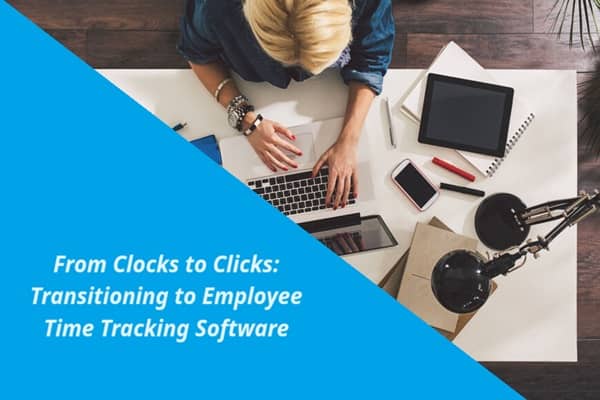From Clocks to Clicks: Transitioning to Employee Time Tracking Software

So, you’ve been tracking employee time the old-fashioned way, with clocks and timesheets, haven’t you? It’s understandable, but the digital era is knocking at your door, offering a world of efficiency and precision that traditional methods just can’t match.
Transitioning to employee time tracking software may seem like a daunting task, but consider the potential benefits: improved accuracy, minimized errors, and enhanced productivity. As we navigate this terrain together, you’ll find there’s more to this software than meets the eye.
So, are you ready to explore the possibilities?
Key Takeaways
- Traditional time tracking methods have significant challenges, prompting a need for more efficient digital solutions.
- Digital timekeeping offers accuracy, real-time data, and enhanced remote team management.
- Employee time tracking software brings benefits like simplified payroll, boosted productivity, and reduced labor costs.
- Successfully transitioning to time tracking software requires selection, setup, training, and support, while overcoming initial resistance and technical issues.
Understanding Traditional Time Tracking
Often, you may find yourself manually logging hours or using outdated punch cards for tracking employee time, methods that aren’t only time-consuming but also susceptible to inaccuracies. These traditional time tracking methods, while familiar, can be riddled with errors and inefficiencies.
For instance, manual timekeeping requires you to fill out timesheets by hand or punch in and out using time cards. It’s a tedious process and you’re likely to make mistakes, especially when you’re in a hurry or trying to recall the exact times you started and finished work. These inaccuracies can lead to payroll errors, which could be costly for your business.
Additionally, traditional time tracking doesn’t provide any insights into employee productivity. You don’t know how much time is being wasted on non-work activities or if employees are working overtime without compensation.
Even worse, if you’re running a large company, you’ll be inundated with stacks of timesheets or punch cards, making it difficult to manage and store them efficiently.
In short, while traditional time tracking methods have served businesses for decades, they’re not without their shortcomings. You’ll need a more efficient and accurate system to manage your employees’ time and productivity.
The Rise of Digital Timekeeping
Acknowledging the flaws in traditional methods, many businesses are now embracing the rise of digital timekeeping to manage employee hours and productivity more efficiently. You may wonder, why the sudden shift? It’s simple: technology affords us convenience and accuracy that manual methods can’t match.
In the past, punch cards and time clocks were the go-to tools for tracking employee hours. But these methods were prone to errors, tampering, and couldn’t provide real-time data. Imagine trying to manage a remote team spread across different time zones using a punch clock! It’d be a nightmare.
Now, digital timekeeping has swooped in to save the day. These systems not only record when your employees clock in and out but also provide insights into their productivity. You can see who’s working on what, for how long, and even where they’re working from. The data is updated in real-time and can be accessed from anywhere, anytime.
Also read: 5 Crucial Considerations for Selecting SIT Testing
Benefits of Employee Time Tracking Software
Undeniably, adopting employee time tracking software can revolutionize your business by providing a plethora of benefits. This cutting-edge technology can simplify payroll processing, boost productivity, enhance accountability, and even reduce labor costs.
Here’s a more detailed breakdown of these advantages:
- Simplified Payroll Processing: Say goodbye to manual timekeeping and hello to automated, accurate payroll. The software accurately logs hours worked, eliminating the risk of human error, and automatically calculates overtime, sick leave, and vacation time. It’s like having your own dedicated payroll assistant!
- Boosted Productivity: Time tracking software provides real-time data on employee work hours, enabling you to identify inefficiencies and optimize workflows. You’ll be amazed how productivity skyrockets when you can accurately track and manage employee time.
- Enhanced Accountability: With automated time tracking, you can ensure your team is accountable for their hours worked. There’s no room for ‘time theft’ or ‘buddy punching’ when every minute is accurately logged and reviewed. A time clock app with geofencing empowers you to streamline workforce management by ensuring employees are clocking in from the right job site. This solution not only provides real-time visibility into employee locations but also enhances operational efficiency, helping you better manage multiple job sites and transform your business operations.
- Reduced Labor Costs: By identifying inefficiencies, you can streamline operations and reduce unnecessary overtime, potentially saving your business a significant amount in labor costs.
Implementing Time Tracking Software
Now that you’re familiar with the benefits, let’s delve into the process of implementing employee time tracking software in your business. The first step is to select a software that aligns with your company’s needs. With a myriad of options out there, it’s essential to consider factors like ease of use, the ability to integrate with existing systems, and the level of customer support provided by the software company.
Once you’ve selected the software, you’ll need to set it up. This usually involves installing it on your company’s devices and configuring the settings to suit your business operations. You might need to set up parameters such as working hours, breaks, and overtime.
Next, it’s vital that you train your employees on how to use the software. This could involve arranging workshops or one-on-one training sessions. It’s crucial that your employees understand how to clock in and out, and how to use any additional features.
Lastly, ensure the software is working as expected. It’s not unusual for glitches to occur during the initial stages, so be prepared to troubleshoot.
Overcoming Transition Challenges
Despite careful planning, you’ll likely encounter a few bumps on the road when transitioning to a new time tracking system. It’s crucial to anticipate these challenges and prepare to overcome them.
- Resistance from Employees: Employees might resist the change, especially if they’re used to the old system. Address their concerns, provide adequate training, and show them the benefits of the new system.
- Technical Difficulties: With any new software, there’s always a chance of technical glitches. Work closely with your software vendor to resolve them quickly.
- Data Migration: Transferring data from the old system to the new one can be a daunting task. Ensure you have a detailed plan in place to avoid loss of valuable data.
- Adaptation Period: It takes time to get used to new software. Allow for an adjustment period and offer ongoing support to your employees.
Conclusion
So, you’ve journeyed from traditional timekeeping to digital, understanding the benefits of employee time tracking software.
You’re implementing it, overcoming transition challenges. Remember, it’s all about enhancing productivity and accuracy. Don’t let the switch intimidate you.
Embrace the change, leverage the benefits, and watch as your business reaps the rewards. It’s time to say goodbye to clocks and hello to clicks.


